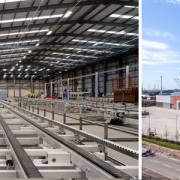The landscape of the UK’s offsite sector has become increasingly populated over the last few years with many new entrants – mostly concentrated on residential development – joining a host of longer-established players. These new entrants are embracing business models based on the manufacture of volumetric modular residential product, rather than other forms of offsite solution such as panellised product. The investment profile of these new entrants suggests that the success or otherwise of their business models directly relates to an ability to operate at scale and achieve high levels of productivity. A recent report1 has highlighted that investment in technology as well as facilities and equipment is key to securing such lofty ambition, particularly emphasising the importance of digitalisation of both product and process.
Building Information Modelling or Digital Engineering
Digitalisation and the power of data-centricity across the wider construction industry is somewhat misunderstood. Most often, parties tend to think that the creation of 3-D models using common software platforms in order that information can be easily shared and the likes of clash detection carried out constitutes all that is required for the building of an information model. Indeed, over the last 10-15 years, new roles such as BIM Manager and BIM Coordinator have emerged across the industry which tend to reflect this limited understanding. Yet the creation of a geometric digital twin in a virtual modelling environment does not really constitute the building of an information model that digitally captures both the product and the process needed to be executed to create the physical entity.
The newer entrants to offsite who are focused on the manufacture of volumetric modular product for the residential sector appear to lack understanding of digitalisation and the power of data-centricity. For such manufacturing-based enterprises, it is not to say that their utilisation of sophisticated software to foster collaborative working to help the efficient development of a geometric digital twin is not beneficial, rather that in itself it is not adequate for the purpose of facilitating scalability and high levels of productivity.
So, returning to the report1 referred to previously, the digitalisation (or digital engineering) of product and process implies a more wide ranging set of activities than just the collaborative development of a geometric digital twin. Whether these enterprises have implemented rigid manufacturing workflow to support the production of a limited range of standard product, or a more flexible manufacturing workflow to support production of mass-customised products, a data-centric logic which facilitates control of the value chain and supports data-driven decision making is a pre-requisite to success. Plainly, an expansive notion of digitalisation and the power of data-centricity reflects something more than the simple idea of building information modelling, and whilst not widely appreciated it really does hold the key to an enterprise realising scale and high levels of productivity.
Data as the New Oil
In order to comprehend the power of data-centricity, enterprises must secure a deep understanding of what data it needs and how it must flow to efficiently operate, and also how data should be authored, configured, manipulated and managed. Most enterprises do not invest the time and effort to secure the necessary insight regarding data creation and flow. Without this understanding, they are unable to determine the nature of the technology platform needed to support the effective digital engineering of product and process. As a result, they typically default to a technology strategy incorporating a set of software packages which cannot be fully integrated, and so ultimately thwart the enterprise’s ability to exploit the power of data. Furthermore, these enterprises tend to recruit resource into their businesses which reflect the conventional skill sets mentioned earlier, which further limits the enterprise’s potential digital engineering and data-centricity prowess.
Of course, for those construction and offsite enterprises who have made relatively low levels of investment to help harness data, such a technology strategy might not be overly constraining because their direct competition might operate in a similar way realising similar mediocre levels of performance. However, for those newer enterprises that will be manufacturing volumetric modular product for the residential sector and who possess an appetite to operate at scale and leverage productivity, it is likely these will encounter serious challenges and such a technology strategy will ultimately prove to represent a weak link.
As was the case when oil was first discovered, the true power of data is still largely unknown. This is not necessarily a criticism, rather just a statement of reality; and if something does not appear to be a problem then resource is not usually allocated to resolving it. And yet, for a manufacturing-based enterprise that wants to operate at scale and with high levels of productivity, a data-centric focus is imperative.
Accordingly, whilst there is additional investment involved in acquiring the necessary talent into a business and affording the same the time to evolve the appropriate process logic and identify the associated technology platform to fully secure control of the value chain and facilitate data-driven decision making, the long-term benefits are enormous. This requirement for investment can be perceived as a leap of faith compared to capital expenditure on machinery, because the power of data-centricity is not readily understood, and often technology projects fail to get delivered. Nonetheless, the infographic on the left contains some examples of the sort of automated data capture / flow that are required in an enterprise that aspires to be a profitable, high-volume manufacturer of volumetric modular product for the residential sector.
The Need for Discretisation of Data
The power of data-centricity can only be realised if an enterprise has a true, granular understanding of what data is important, what format it needs to be presented in, which resource needs what portions, and what point in time it requires to be created. An enterprise must seek to understand what data it needs and how it must flow to efficiently operate, and crucially how the same should be authored, configured, manipulated and managed. It is only when an enterprise develops a profound insight that it can also start to consider how the authoring, configuring, manipulating and managing of data can be automated. Indeed, for those newer entrants to the offsite sector who want to operate at scale and achieve high levels of productivity, one option often used to compensate for not comprehending the power of data-centricity is to simply employ more resource. Given the fragmented, skills-scarce climate that such businesses might currently be operating in, this sort of compensatory mechanism ultimately remains a limiting factor to achieving scale and high levels of productivity. The rationale behind this is straightforward enough: the skill sets of many of the sorts of people operating across the construction and offsite sectors are not sufficiently broad to properly understand the full idea that lies behind digitalisation. Whilst some of these enterprises might have a fairly advanced understanding of what to build, they are characteristically lacking in terms of their understanding of how something should be built.
The true power of data-centricity can only be realised if data is discretised, that is the packets of data that are shared between two actors (e.g., from person-to-person, or person-to-machine) only contain information that is relevant to that particular transaction. Any exchange of data which involves surplus, superfluous, imprecise or erroneous information only gives rise to inefficient working because process time is wasted stripping out the unnecessary components of the communication and validating that the remainder is adequate and accurate to facilitate processing. Furthermore, it is crucial to comprehend the importance of data purity and data integrity, so it is essential to create process logic that affords management and maintenance of data sets to avert risk of data pollution. Where data is discretised, such process logic is easier to identify and implement because the size of data packets can be configured to be easier to handle. So, any offsite providers that can secure control of the value chain and facilitate data-driven decisions is likely to become a sector lead. To summarise, the value to any enterprise of acquiring a granular understanding of the power of data-centricity, including what data is important and how it must flow, is the essence of digitalisation and it is this knowledge that will enable scale and realisation of high levels of productivity.
1McKinsey & Company “The next normal In construction – How disruption is reshaping the world’s Largest ecosystem” June 2020
www.berkeleygroup.co.uk






